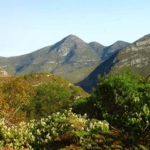The Outeniqua Mountains
The Outeniqua Mountains run parallel to the southern coast of the cape. The mountains form a continuous range adjoining the Langeberg range to the West and the Tsitsikama range to the East. The San and Khoi people lived here when the European settlers arrived after 1668. Their rock paintings can still be found in the area.
The shape of the Outeniqua mountains is characterized by gentle slopes on the Southern face with steep drops on the Northern face. Two of the highest peaks are Cradock Peak at 1578 m and George Peak at 1370 m. This shape creates diverse habitats. The upper southern slopes are covered with Fynbos and the median slopes with Afromontane forests. The northern side is covered with Renosterveld shrubland. High rainfall fills perennial streams which are used for irrigation.
Summer Weather is generally moderate but in winter temperatures can be as low as 5 °C when snow sometimes covers the peaks
Mountain Passes
Work began on a rail route over the range in 1908, which involved 7 tunnels. The line was completed in 1913.
The Cradock Pass, sometimes called The Voortrekker Road, was completed in 1816, but it was not well constructed, and The Montague Pass, constructed using convict labour, was begun in 1847. Demand for access to the interior increased and in 1943 construction began on the Outeniqua pass. Labour was provided by Italian prisoners of war. After the war ended, the prisoners returned and the pass only opened in 1951. Two other road passes are the Robinson Pass and Prince Alfred’s Pass
*The meaning of the name”Outeniqua”?
Outeniqua are the people who lived along the mountains and rivers in the area now called Outeniqua. There are many of the descendants of this group still living here. We can try to understand people better when we know how they describe themselves. The name is believed to come from the Khoi Khoi name, which means They who bear honey.*
The suffix ‘qua’ in the Khoi language refers to a group of people such as a tribe.
‘qua’ is a codified form of! wa, and is sometimes written as Kua, Khwe, in a suffix form to show it is a people group being referred to. The word means ‘people’
Au: honey (this is an old word found also in the ! Kwingkia language) …..Teni: to carry……. Qua: people
Auteniqua … Honey-bearing people |Ainikhwe or Chainuqua (the river people).
Many cave paintings have been found in the Outeniqua Mountains depicting people gathering honey. The culture of honey collecting is ancient.


